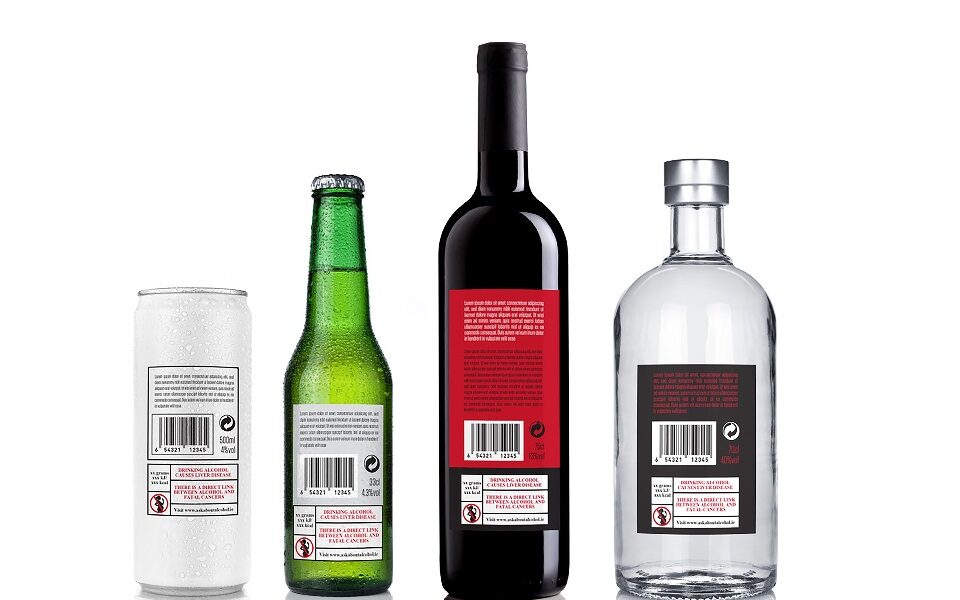Should alcoholic beverages have cancer warning labels?

Fifteen words are roiling the global alcohol industry.
Beginning in 2026, containers of beer, wine and liquor sold in Ireland will be required by law to bear a label in red capital letters with two warnings: “There Is a Direct Link Between Alcohol and Fatal Cancers” and “Drinking Alcohol Causes Liver Disease.”
The requirement, signed into law last year, is backed by decades of scientific research and goes much further than any country has thus far communicated the health risks of alcohol consumption. It has sparked fierce opposition from alcohol businesses worldwide, but it is also inspiring a push in some other countries to pursue similar measures.
“It’s an important step,” said Dr. Timothy Naimi, director of the Canadian Institute for Substance Use Research at the University of Victoria. “People who drink should have the right to know basic information about alcohol, just as they do for other food and beverage products.”
In Thailand, the government is in the final stages of drafting a regulation requiring alcohol products to carry graphic images accompanied by text warnings such as “alcoholic beverages can cause cancer,” according to The Bangkok Post.
A bill has been introduced in the Canadian Parliament that would require labels on all alcoholic beverages to communicate a “direct causal link between alcohol consumption and the development of fatal cancers.”
Last week, the Alaska Legislature held a committee hearing on a bill that would require businesses selling alcohol to post signs carrying a cancer warning.
Norway, which already heavily regulates the sale of alcohol, is developing proposals for introducing cancer warning labels. The country’s state secretary, Ole Henrik Krat Bjorkholt, who followed Ireland’s effort with great interest, said in an interview, “I think it’s probable that we will implement something similar.”
Ireland has been a trailblazer in setting aggressive public health policies before. In 2004, it became the first country to ban smoking in indoor workplaces, including bars and restaurants, a policy since adopted in more than 70 countries. The warning label requirement for alcohol could be the start of a similar change in how beverages are packaged, and a vehicle for raising awareness about the dangers of drinking, however small the amount.
Long fight
The evidence linking drinking and cancer is well established. In 1988, the World Health Organization’s International Agency for Research on Cancer concluded that alcohol is carcinogenic to humans. Research in the decades since has only strengthened the conclusion, including for breast, liver, colorectal and esophageal cancers. In November, the WHO and the IARC declared in a joint statement: “No safe amount of alcohol consumption for cancers can be established.”
Despite this, the connection between alcohol and cancer isn’t well known. In the United States, a recent nationwide survey found that about 1 in 3 Americans was aware that drinking increased the risk of cancer.
Globally, only one-fourth of countries require any kind of health warning on alcohol, according to a recent study, and the mandated language is generally imprecise. The United States last altered its warning labels in 1989, when it introduced language that discouraged drinking during pregnancy, or before driving or operating heavy machinery, and that vaguely acknowledged that alcohol “may cause health problems.”
It took more than a decade for Ireland’s labeling requirement to become a reality, according to Sheila Gilheany, CEO of the advocacy organization Alcohol Action Ireland, who described it as “the most contested piece of legislation in Irish history.” She said the effort began in 2012, when a steering group assigned to address the country’s high rate of alcohol-related deaths recommended a raft of measures, including warning labels.
Many of the recommendations were watered down by the time they became law in 2018, but the labeling requirement made it through unscathed. It took another four years for lawmakers to hammer out the specific wording and the design that would be required.
As those details were decided, alcohol companies stepped up their protests. In late 2022, a group of major alcohol-exporting European countries submitted formal objections to the European Commission, the European Union’s executive branch, arguing that Ireland’s labels impeded free trade and were not appropriate or proportionate to the objective of reducing alcohol’s harms.
When the commission raised no objection, Antonio Tajani, Italy’s foreign minister, called the Irish proposal “an attack on the Mediterranean diet.” The language in the labels “doesn’t take into account the difference between moderate consumption and alcohol abuse,” he said on Twitter.
Coordinated industry opposition
Alcohol businesses are fighting on multiple fronts to keep the Irish labeling requirement from taking effect. At committee meetings of the World Trade Organization in June and November, trade groups and 11 alcohol-exporting countries, including the United States, expressed concerns, questioned the scientific validity of the cancer warning and argued that Ireland’s labels would infringe on free trade.
In comments submitted to the WTO, the Distilled Spirits Council of the United States called the labels “inaccurate” and “misleading.” The group also suggested that “this important public health objective would be best managed” as part of a parallel effort to address cancer in the EU, an area where the alcohol industry has proved to have greater influence.
The European Commission was supposed to propose language for alcohol health warnings as part of the its Beating Cancer Plan by the end of 2023 but failed to meet that deadline. In December, over the objections of the WHO, the European Parliament approved a report that did not affirm the need for warning labels, instead calling for information on “moderate and responsible drinking.”
In the final report, its authors repeatedly watered down language about alcohol’s role in disease, narrowing warning only about “harmful” or “excess” of consumption.
Size and design
Cormac Healy, director of Drinks Ireland, a trade group, said his organization wasn’t entirely opposed to health warnings. But he said the mandated size of the labels would be impractical for use on smaller products, picking a 50-milliliter bottle up from his desk to demonstrate. And the warning language itself was “disproportionate and inaccurate,” he said, and primarily geared toward scaring people.
“To inform, to educate – you can’t really do that on a label,” he added.
In the United States, alcohol warning labels are typically on the back of the bottle or can, where they blend in with other graphic features. Dr. Marissa Hall, an assistant professor in the department of health behavior at the University of North Carolina at Chapel Hill, said the labels would be more effective at catching a purchaser’s eye if they were on the front, included an image or icon, and featured one of a rotating group of brief messages.
Hall recently received a grant from the National Institutes of Health to test the impact of stronger design features. When she tells friends about her research, many are surprised to learn the United States requires warning labels at all, she said, because the existing ones so easily go unnoticed.
“They have no idea,” she said.
In the past 15 years, a few countries have proposed stronger alcohol warning labels, but each has been met with fierce opposition, said Paula O’Brien, a professor of law at the University of Melbourne. In 2010, Thailand proposed requiring a rotating group of warnings accompanied by graphic color imagery; O’Brien called it “the high-water mark for alcohol labeling.” But at the WTO, other countries raised concerns that the labels would restrain free trade, and the measure stalled.
In 2016, South Korea overcame similar objections to mandate a group of warning labels – some of which link alcohol with cancer – from which alcohol makers can choose to put on their products.
Even research on the topic has been contentious. In 2017, Yukon, a sparsely populated territory in northwest Canada, forged a partnership with scientists to introduce and test the impact of brightly colored warning labels, one of which included the phrase “alcohol can cause cancer.” But after alcohol trade groups complained, the local government paused the study out of fear that it would face a lawsuit that it could not afford to fight.
“I was a bit surprised about the strength of the reaction,” said Dr. Erin Hobin, a scientist at Public Health Ontario who led the project in Yukon.
When the researchers resumed the study several months later, on the condition that the cancer warning be omitted, they found that people buying alcoholic beverages featuring the labels were still more likely to notice the messages, and reported reducing their drinking. Sales of products carrying the labels also fell by about 7% during the intervention and several months that followed.
Most important, Hobin said, as drinkers grew more informed about the link between alcohol and cancer, they also became more likely to support policies for controlling alcohol availability, pricing and marketing, which have been shown to reduce drinking even more.
If the alcohol industry dissuaded the EU from adopting warning labels, it would keep Ireland isolated and out of harmony with European law. That could ultimately form a basis for challenging the labeling requirement in Irish courts, said Dr. Ollie Bartlett, an assistant professor of law at Maynooth University in Ireland. But he said that such efforts were unlikely to prevail because Ireland’s alcohol warning labels are “proportionate to the objective of protecting public health.”
Observers say the EU isn’t likely to take any further action until after parliamentary elections this summer. And there’s no indication that Ireland will retreat from its commitment to require the labels starting in May 2026.
Dr Gauden Galea, a strategic adviser at the WHO, said he was confident that broader labeling efforts would eventually succeed. At 63, he’s old enough to recall how cigarette companies once advertised on the front pages of newspapers, he added.
Eventually, he hopes, “People will not remember the time when you needed a warning on pesticides, but could sell an unlabeled carcinogen like alcohol with impunity.”
This article originally appeared in The New York Times.






